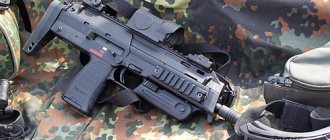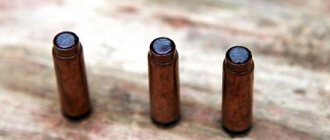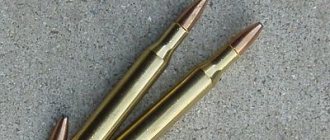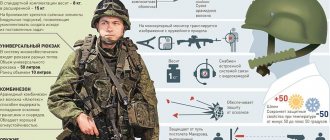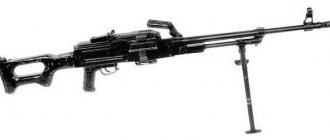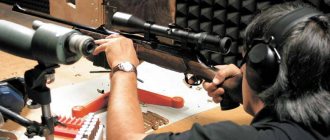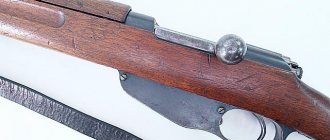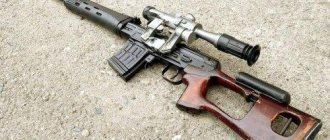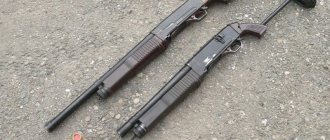| .30 Carbine | |
| .30 Carbine (7.62×33 mm) | |
| Cartridge type: | unitary cartridge |
| Manufacturer country: | USA |
| Cartridge: | 7.62×33 mm |
| Service history: | |
| Used: | see Operating countries |
| Wars and conflicts: | The Second World War] |
| Production history: | |
| Constructor: | David Marshall Williams] |
| Time of creation: | 1940-1941] |
| Manufacturer: | Winchester] |
| Options: | see Cartridge nomenclature |
| Characteristics: | |
| Chuck length, : | 42, 67] |
| Current bullet caliber: | 7, 82 |
| Bullet weight: | 7, 1] |
| Sleeve length: | 32, 77] |
| Case neck diameter, : | 8, 53] |
| Sleeve base diameter, : | 9, 04] |
| Sleeve flange diameter, : | 9, 14] |
| Powder charge mass, : | 0, 94 |
| Initial bullet speed, m/s: | 607] |
| Bullet energy: | 1308] |
| Test barrel length: | 457, 2 |
.30 Carbine
(7.62x33 mm) is a unitary cartridge developed in the United States during World War II for use in the M1 lightweight carbine
.
The cartridge was created in 1941 on the basis of the old American hunting ammunition .32 WSL. In terms of power, it is inferior to intermediate cartridges, but superior to pistol cartridges, so it is difficult to unambiguously classify it as any specific type. In terms of power and design, it resembles magnum revolver cartridges. In addition to the carbine itself, the .30 Carbine cartridge is used in a number of revolvers and pistols, such as the Ruger Blackhawk or AMT AutoMag III
.
Story
The .30-06 rifle cartridge (7.62×63 mm) used by American troops during World War II had excessive power, so automatic weapons for it necessarily had to be massive and large-sized. Therefore, the idea arose to create a less powerful ammunition and a weapon for it, intended for driver mechanics, soldiers of auxiliary units, officers, as well as other categories of military personnel who usually do not participate in combined arms combat, who did not make sense to arm with a “full-size” rifle - such a weapon , which, while maintaining sufficient effectiveness in close combat, would be light and compact enough so as not to unnecessarily burden the user while performing his main job duties.
In other countries at that time they followed the path of using submachine guns for these purposes chambered for pistol cartridges available in service, but in the United States at that time there was no clearly successful design of a submachine gun (the Thompson PP adopted for limited service at that time was too heavy and very expensive to manufacture), in addition, they feared that the range and accuracy of fire from a submachine gun would be insufficient to solve some combat missions. In addition, the powerful US economy, which had not suffered at all during the world war that was already underway at that time, allowed them to successfully supply troops with three types of ammunition for small arms (rifle, pistol and carbine), which at that time remained outside the scope of reach of most other countries[3].
The decision to develop such a cartridge was made on October 1, 1940, at a meeting of representatives of commercial arms companies with the US Defense Committee.[1]
Winchester began developing a cartridge called the .30 SR M-1 based on its old small-to-medium game hunting cartridge, the .32 WSL[en]. By December 1940, a pilot batch of cartridges with lead bullets weighing 6.9 g in a tombak shell was produced. In January and June, industrial batches of 50,000 cartridges each are sent for testing, and in the fall a batch of 300,000 cartridges with a different type of gunpowder is released.[1]
On October 30, 1941, the cartridge was adopted by the US Army under the designation Cartridge, Carbine Cal. .30 M-1
. However, the improvement of the cartridge did not end there; for example, replacing the brand of gunpowder, carried out in April 1942, made it possible to increase the initial speed of the bullet by 10%, however, attempts to replace the case material from brass to galvanized steel or aluminum were unsuccessful, as was the development of an armor-piercing bullet for of this cartridge.[1]
In addition to the serial carbines produced by Winchester - self-loading and automatic M2 - a third-party company Auto-Ordnance, which produced Thompson submachine guns, experimentally developed the so-called (Thompson Light Rifle) for this cartridge. This weapon was, to some extent, an analogue of the German “Sturmgever”, with a simplified stamped and welded design, adapted for mass production. But the American military was not interested in it and remained a prototype.
After the end of the war, a large number of carbines went on sale on the civilian market. Due to the peculiarities of the ballistics of the bullet, the cartridge was not of interest to hunters, but it attracted people interested in sports shooting, as well as police officers.
History[edit | edit code]
The .30-06 rifle cartridge (7.62×63 mm) used by American troops during World War II had excessive power, so automatic weapons for it necessarily had to be massive and large-sized. Therefore, the idea arose to create a less powerful ammunition and a weapon for it, intended for driver mechanics, soldiers of auxiliary units, officers, as well as other categories of military personnel who usually do not participate in combined arms combat, who did not make sense to arm with a “full-size” rifle - such a weapon , which, while maintaining sufficient effectiveness in close combat, would be light and compact enough so as not to unnecessarily burden the user while performing his main job duties.
In other countries at that time they followed the path of using submachine guns for these purposes chambered for pistol cartridges available in service, but in the United States at that time there was no clearly successful design of a submachine gun (the Thompson PP adopted for limited service at that time was too heavy and very expensive to manufacture), in addition, they feared that the range and accuracy of fire from a submachine gun would be insufficient to solve some combat missions. In addition, the powerful US economy, which had not suffered at all during the world war that was already underway at that time, allowed them to successfully supply troops with three types of ammunition for small arms (rifle, pistol and carbine), which at that time remained outside the scope of reach of most other countries[4].
The decision to develop such a cartridge was made on October 1, 1940, at a meeting of representatives of commercial arms companies with the US Defense Committee.[1]
Winchester began developing a cartridge called the .30 SR M-1 based on its old small-to-medium game hunting cartridge, the .32 WSL[en]. By December 1940, a pilot batch of cartridges with lead bullets weighing 6.9 g in a tombak shell was produced. In January and June, industrial batches of 50,000 cartridges each are sent for testing, and in the fall a batch of 300,000 cartridges with a different type of gunpowder is released.[1]
On October 30, 1941, the cartridge was adopted by the US Army under the designation Cartridge, Carbine Cal. .30 M-1
. However, the improvement of the cartridge did not end there; for example, replacing the brand of gunpowder, carried out in April 1942, made it possible to increase the initial speed of the bullet by 10%, however, attempts to replace the case material from brass to galvanized steel or aluminum were unsuccessful, as was the development of an armor-piercing bullet for of this cartridge.[1]
In addition to the serial carbines produced by Winchester - self-loading and automatic M2 - a third-party company Auto-Ordnance, which produced Thompson submachine guns, experimentally developed the so-called (Thompson Light Rifle) for this cartridge. This weapon was, to some extent, an analogue of the German “Sturmgever”, with a simplified stamped and welded design, adapted for mass production. But the American military was not interested in it and remained a prototype.
After the end of the war, a large number of carbines went on sale on the civilian market. Due to the peculiarities of the ballistics of the bullet, the cartridge was not of interest to hunters, but it attracted people interested in sports shooting, as well as police officers.
Further use of the cartridge
AutoMag III
After the end of the World War in the Dominican Republic, the Hungarian emigrant designer Paul Kiraly developed the Cristobal M2 automatic carbine chambered for the .30 Carbine cartridge. Its design was a curious hybrid of two systems - the Hungarian 39M submachine gun, an earlier development of Kiraly himself (from which the weapon inherited the principle of automatic action with a semi-blowback) and the Italian Beretta M1938 submachine gun, produced in the Dominican Republic under license (from which the weapon received the trigger a mechanism with two triggers arranged in tandem, playing the role of a fire type selector).
Additionally, the .30 Carbine cartridge is used in a number of revolvers and pistols, such as the Ruger Blackhawk or AMT AutoMag III.
In 1994, in Israel, a Magal carbine was created for this cartridge, the design of which is based on the Galil assault rifle (AK variant). Since 2001, due to numerous complaints from operators about low reliability, it was withdrawn from service. Meanwhile, the original M1 carbine remains in service with the Israeli police and civil defense forces.
Further use of the cartridge[edit | edit code]
AutoMag III
After the end of the World War in the Dominican Republic, the Hungarian emigrant designer Paul Kiraly developed the Cristobal M2 automatic carbine chambered for the .30 Carbine cartridge. Its design was a curious hybrid of two systems - the Hungarian 39M submachine gun, an earlier development of Kiraly himself (from which the weapon inherited the principle of automatic action with a semi-blowback) and the Italian Beretta M1938 submachine gun, produced in the Dominican Republic under license (from which the weapon received the trigger a mechanism with two triggers arranged in tandem, playing the role of a fire type selector).
Additionally, the .30 Carbine cartridge is used in a number of revolvers and pistols, such as the Ruger Blackhawk or AMT AutoMag III.
In 1994, in Israel, a Magal carbine was created for this cartridge, the design of which is based on the Galil assault rifle (AK variant). Since 2001, due to numerous complaints from operators about low reliability, it was withdrawn from service. Meanwhile, the original M1 carbine remains in service with the Israeli police and civil defense forces.
Unusual carbine chambered for a non-standard cartridge
The American army continues to develop its program to create fundamentally new ammunition and lightweight small arms. Yesterday, the portal military.com reported that as part of the specialized exhibition Modern Day Marine, which is taking place these days in the American city of Quantico (Virginia), Textron Systems Corporation showed a 6.5 mm carbine that fires telescopic cartridges.
In 2004, as part of the US Armed Forces Joint Service Small Arms Program (JSSAP), created to standardize the weapons of the American army, the development of Lightweight Small Arms Technologies (LSAT) was launched. The goal of LSAT is to develop fundamentally new ammunition and small arms that will be lighter and more compact than the models in service with the US Army today.
Testing of new ammunition and weapons developed under the LSAT program
Eight weapons companies, led by the American corporation AAI, are contractors under the LSAT program. In 2008, the first samples of new ammunition of 5.56 and 7.62 mm calibers were developed, as well as various versions of the LMG light machine gun for these calibers. During army tests conducted in 2012, a special JSSAP commission selected two variants of new cartridges for further work - caseless (the bullet is recessed into a compressed powder mixture) and telescopic (the bullet is inside a plastic sleeve, recessed into the powder mixture). Both ammunition was approximately 40% lighter than a traditional brass-cased cartridge and significantly shorter.
Telescopic cartridges compared to standard cased ammunition military.com
The new carbine from Textron Systems is called the 6.5 CS Carbine (6.5mm case-telescoped carbine) and is designed for 6.5 mm telescopic cartridges. According to Ben Cole, project engineer at CS Carbine, the new weapon model was created for the 6.5 mm ammunition developed in 2014, presented as an intermediate option between telescopic cartridges of 5.56 and 7.62 mm calibers. According to the description, 6.5 mm telescopic cartridges are almost identical to 7.62 mm ammunition in terms of ballistic characteristics and at the same time are significantly lighter. In addition, the kinetic energy of a 6.5 mm bullet is 300% greater than that of its 5.56 mm counterpart.
Prototype 6.5 CS Carbine military.com
The prototype 6.5 CS Carbine weighs almost 4 kg and is fed from 20-round magazines. According to Cole, the first working prototypes of the new assault rifles will be tested by the American army early next year. After modifications (weight reduction), the new carbines will have a high chance of replacing M4A1 assault rifles in the US Armed Forces.

